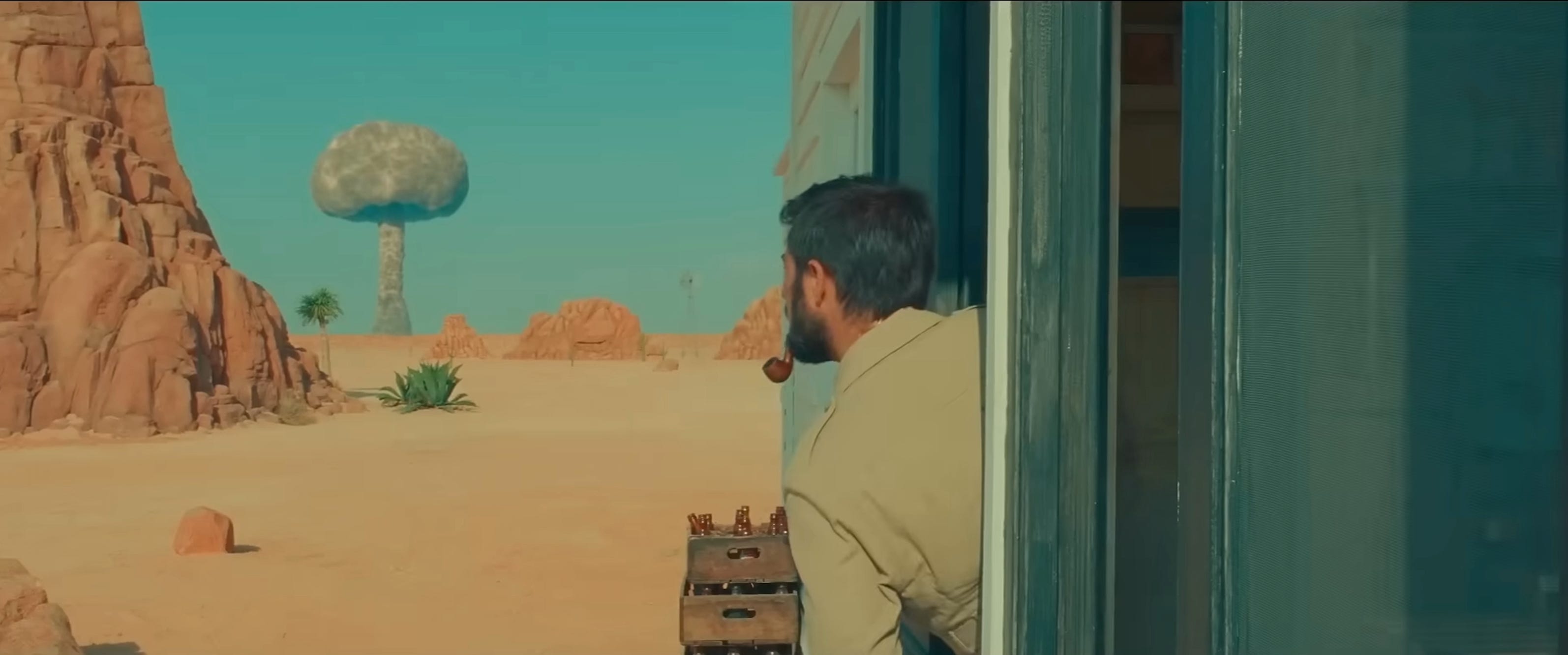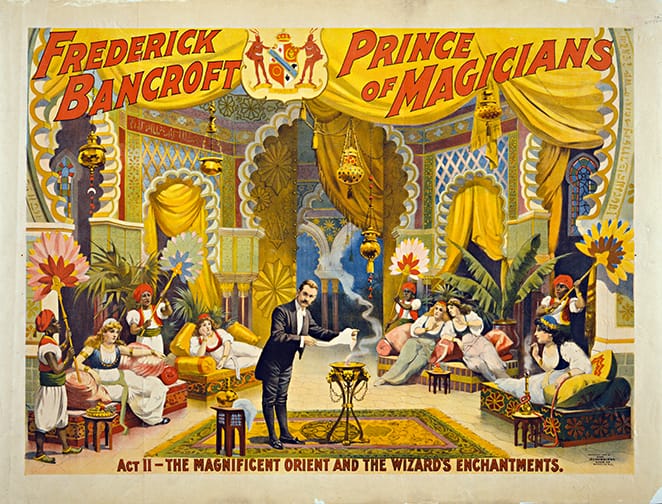"Asteroid City" Reviewed

Late in Asteroid City, a refrain emerges: you can’t wake up if you don’t fall asleep.
The line is hardly deployed casually–it becomes a sort of rallying cry before lending itself to the end credits song–and it suits the apparent raison d'être of Wes Anderson’s 11th feature film, a movie distinctly opposed to allowing the audience to fall under the sway of its story.
In Asteroid City–which opens today in New York and L.A. before going wide next week–we’re never allowed the luxury of succumbing to a false world and losing ourselves in a narrative. The film’s naturalism is punctured constantly courtesy of a framing device that’s notable even among Anderson’s usual scaffolding conceits. The Royal Tenenbaums is a novel, The French Dispatch is a collection of magazine articles, and Asteroid City, we’re never allowed to forget, is a play.
First and foremost, though, Asteroid City is an antic yarn that’s equal parts Looney Toons and Close Encounters of the Third Kind, all of it streaked with Anderson’s characteristic wistful ennui and a newly enlivened deadpan absurdism. In the simplest terms–the terms by which it’s being advertised–the film takes place in a southwest desert outpost in September 1955. The town (such as it is) serves as home to both a meteor’s blast crater and a gathering of child prodigies, the impeccably Andersonian Junior Stargazers and Space Cadets, whose meeting offers this loose story something like a shape. In attendance are photojournalist Augie Steenbeck (Jason Schwartzman) and his four children, the eldest of whom (Jake Ryan) is participating in the conference, while the younger three quickly busy themselves with an atypical mourning process for the mother they’ve just learned died three weeks ago. The brood is soon joined by Augie’s father-in-law, Stanley Zak (Tom Hanks), who arrives to pick them up after their car suffers catastrophic malfunction, while also along for the proceedings are Midge Campbell (Scarlett Johansson), a movie star accompanied by her own very gifted child, J.J. Kellogg (Liev Schreiber), baffled by a son who can only experience life as an escalating series of dares, and General Grif Gibson (Jeffrey Wright), who hosts the Junior Stargazers’s scholarship award ceremony. This rundown only scratches the surface of a comically packed ensemble cast (the poster lists 21 recognizable names), with a bifurcated structure offering double the opportunity for pop-ins from A-listers.
Because not only is Asteroid City a play, it is a movie about that play and its history. Anderson’s framing device is remarkably knotty–as we learn in a midcentury TV broadcast being hosted by a Rod Serling type (Bryan Cranston), the stage play Asteroid City was written by Conrad Earp (Edward Norton) and directed by Schubert Green (Adrien Brody). We see brief glimpses of the production before falling into the naturalistic world of Asteroid City–which must be viewed as a sort of adaptation of Earp’s script–while frequently toggling back to the world of the TV broadcast, which depicts several sequences from the making of the play.
Anderson is very specific about the play’s time and place–this is the avant-garde theater world of 1955, and that places it directly in the absurdism boom that kicked off with Waiting for Godot and went on to encompass works by Ionesco, Pinter, and Edward Albee, among others. Like classic works of absurdism, Asteroid City is concerned with the search for meaning in a seemingly random universe–even the boy who compulsively begs to be dared to complete physical challenges admits he’s just looking for some shape to his otherwise amorphous existence–and like classic works of absurdism, Anderson employs alienation effects that keep us from sinking entirely into the world of the story (title cards keep us constantly grounded in which act and scene we’re currently viewing, with occasional stage direction offering hints on tone). Asteroid City is not a film that allows you to fall asleep. For as loose and dreamy as its hazy desert story may be, it demands you stay awake.
The knock on Anderson tends to be that he’s style over substance, running an aesthetic toolkit into the ground while growing increasingly distant from human emotion. I’ll admit to having felt some frustration on initial contact with Moonrise Kingdom and The Grand Budapest Hotel, films that did feel mannered to the point of airlessness. But the deadpan zip of Anderson’s worldview is only growing more sophisticated in its interaction with emotion, not less so–it may sometimes take a scratch or two at the surface, but the depth of pain in Moonrise Kingdom or The Grand Budapest Hotel isn’t hard to detect for anyone without a chip on their shoulder.
Asteroid City forms an interesting counterpoint in the perpetual argument over Anderson’s relationship to unruly emotion amidst his storybook worlds. The Royal Tenenbaums (still, for my money, his masterpiece, and the kind of act it’s hard to imagine he’ll ever top) features Chas (Ben Stiller), widower and father of precocious young children, a raw nerve of a character whose ultimate soul-bearing “I’ve had a tough year, Dad” serves as the story’s emotional lodestone. Here, we have Augie, widower and father of precocious young children, but the character is weighted with so many arch flourishes and mannerisms that he’s never allowed to access Chas’s genuine pathos.
But isn’t Anderson cannier than that? Shouldn’t we be reading the full-color Augie as Earp’s character, not his? Isn’t this, in fact, Schubert Green’s production? It’s when inhabiting the role of the actor playing Augie in the monochrome framing device that Schwartzman demonstrates something closer to naturalism. Is the full-color story, then, a parody of midcentury existentialist drama, or at least a winking pastiche? Which is the “real” story, if such a distinction matters at all? It’s hard to say just what this endearingly pretzel-shaped film is, a fact that leaves it feeling simultaneously like minor-key Anderson and perhaps his most intellectually expansive story yet.
Absurdist works were often concerned with the existential anxiety that accompanied the end of World War II, particularly the rearrangement of cosmic priorities that came with the invention of the atomic bomb, a threat so present in Asteroid City that it’s played for goofs rather than terror. And like so many works of absurdism, the characters in Asteroid City are more or less returned to the status quo after an extraordinary encounter with the cosmic wilderness (the alternate title for Earp’s play). There’s always another bomb going off over the horizon, always another high-speed chase racing by, and always another day left to live until we shuffle offstage and discover once and for all whether there was any purpose to any of it.
At one point late in Asteroid City, Augie commits an act of mild self-mutilation. The moment is so startling it breaks the reality of the film–Schwartzman, now slipping into the role of the actor playing Augie, storms off to find Schubert Green, to whom he cries, “I still don’t understand the play.”
“It doesn’t matter,” Green tells him. “Just keep doing the story.”
The play’s the thing–the whole existential thing we’re stuck wrestling with as we stumble through the story of our lives. And if there’s anything as trite as a message in Asteroid City, a sweet to balance out the acid of You can’t wake up if you don’t fall asleep, it’s that small comfort: we don’t have to understand the play. It’s enough to just focus on the story.

These are the first words I’ve published at this newsletter in about six months, and I’m largely writing them now to prove that I’m still here doing my own story, no matter how uncertain I remain concerning the play. In my December exegesis on my own mental health (and Elvis) I worried that I was about to go dark for an unknown period of time, and that’s exactly what happened–when I crashed in January, I crashed hard, losing my mojo in every sense of the term. For most of 2023 I’ve been too groggy to produce good work thanks to the good hard dial-crank on the antipsychotic my doctor prescribed to bring me back down to earth from a manic episode. We’ve eased off a bit in the past couple of months, largely to keep me from being too draggy to effectively get through the day, and I’ve come back to feeling somewhat like myself, but only barely. I’m still pretty sleepy, but sleepy in the manner of Sergeant X in J.D. Salinger’s “For Esmé–With Love and Squalor,” the shell-shocked World War II veteran who uses the word in place of traumatized. As the story ends: You take a really sleepy man, Esmé, and he always stands a chance of again becoming a man with all his fac—with all his f-a-c-u-l-t-i-e-s intact.
So today, I bring you a brief Asteroid City review. I probably could have written an essay on the film, maybe digging more into postwar anxieties and cartoons and the world of 1950s acting studios. It would all be a lot of fun. But rather than sink into it for a few weeks, I wanted to get something out fast, just to test whether my f-a-c-u-l-t-i-e-s are intact.
That’s it for now. I imagine I’ll be writing more here at some point, though I’m not sure how regularly that will be. I do have a second book to finish, so if you don’t hear from me for a while, trust that that’s the reason rather than psychological blackout. That seems like a good thing to hope for. In the meantime, quoth the Toons: Th-th-th-th-th-th-th-th-th-that’s all folks.




